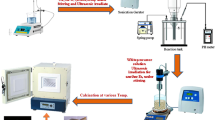Abstract
Hydroxyapatite (HAP) is the constituent of calcium phosphate based bone cement and it is extensively used as a bone substitute and drug delivery vehicle in various biomedical applications. In the present study we investigated the release kinetics of ciprofloxacin loaded HAP and analyzed its ability to function as a targeted and sustained release drug carrier. Synthesis of HAP was carried out by combustion method using tartaric acid as a fuel and nitric acid as an oxidizer. Powder XRD and FTIR techniques were employed to characterize the phase purity of the drug carrier and to verify the chemical interaction between the drug and carrier. The synthesized powders were sieve separated to make two different drug carriers with different particle sizes and the surface topography of the pellets of the drug carrier was imaged by AFM. Surface area and porosity of the drug carrier was carried out using surface area analyzer. The in-vitro drug release kinetics was performed in simulated body fluid, at 37.3°C. The amount of ciprofloxacin released is measured using UV-visible spectroscopy following the characteristic λ max of 278 nm. The release saturates around 450 h which indicates that it can be used as a targeted and sustained release carrier for bone infections.
Similar content being viewed by others
References
Cai L, Guinn A S, Wang S. Exposed hydroxyapatite particles on the surface of photo-crosslinked nanocomposites for promoting MC3T3 cell proliferation and differentiation. Acta Biomaterialia, 2011, 7(5): 2185–2199
Laurent F, Bignon A, Goldnadel J, et al. A new concept of gentamicin loaded HAP/TCP bone substitute for prophylactic action: in vitro release validation. Journal of Materials Science: Materials in Medicine, 2008, 19(2): 947–951
Jain A K, Panchagnula R. Skeletal drug delivery systems. International Journal of Pharmaceutics, 2000, 206(1–2): 1–12
Shinto Y, Uchida A, Korkusuz F, et al. Calcium hydroxyapatite ceramic used as a delivery system for antibiotics. The Journal of Bone & Joint Surgery (British Volume), 1992, 74(4): 600–604
Wahlig H. Gentamicin-PMMA beads: a drug delivery system in the treatment of chronic bone and soft tissue infections. Journal of Antimicrobial Chemotherapy, 1982, 10(5): 463–465
Dunn M G, Bellincampi L D, Tria A J Jr, et al. Preliminary development of a collagen-PLA composite for ACL reconstruction. Journal of Applied Polymer Science, 1997, 63(11): 1423–1428
Kopecek J. The potential of water-soluble polymeric carriers in targeted and site-specific drug delivery. Journal of Controlled Release, 1990, 11(1–3): 279–290
Otsuka M, Nakahigashi Y, Matsuda Y, et al. Novel skeletal drug delivery system using self-setting calcium phosphate cement VIII: The relationship between in vitro and in vivo drug release from indomethacin-containing cement. Journal of Controlled Release, 1997, 43(2–3): 115–122
Sasikumar S, Vijayaraghavan R. Effect of metal-ion-to-fuel ratio on the phase formation of bioceramic phosphates synthesized by self-propagating combustion. Science and Technology of Advanced Materials, 2008, 9(3): 035003 (5 pages)
Han Y, Li S, Wang X, et al. Synthesis and sintering of nanocrystalline hydroxyapatite powders by citric acid sol-gel combustion method. Materials Research Bulletin, 2004, 39(1): 25–32
Burgos A E, Belchior J C, Sinisterra R D. Controlled release of rhodium(II) carboxylates and their association complexes with cyclodextrins from hydroxyapatite matrix. Biomaterials, 2002, 23(12): 2519–2526
Rogers-Foy J M, Powers D L, Brosnan D A, et al. Hydroxyapatite composites designed for antibiotic drug delivery and bone reconstruction: a caprine model. Journal of Investigative Surgery, 1999, 12(5): 263–275
Cohen S, Yoshioka T, Lucarelli M, et al. Controlled delivery systems for proteins based on poly(lactic/glycolic acid) microspheres. Pharmaceutical Research, 1991, 8(6): 713–720
Misiek D J, Kent J N, Carr R F. Soft tissue responses to hydroxylapatite particles of different shapes. Journal of Oral and Maxillofacial Surgery, 1984, 42(3): 150–160
Bose S, Dasgupta S, Tarafder S, et al. Microwave-processed nanocrystalline hydroxyapatite: simultaneous enhancement of mechanical and biological properties. Acta Biomaterialia, 2010, 6(9): 3782–3790
Castro C, Snchez E, Delgado A, et al. Ciprofloxacin implants for bone infection. In vitro-in vivo characterization. Journal of Controlled Release, 2003, 93(3): 341–354
Cobby J, Mayersohn M, Walker G C. Influence of shape factors on kinetics of drug release from matrix tablets. I. Theoretical. Journal of Pharmaceutical Sciences, 1974, 63(5): 725–732
Murugan R, Ramakrishna S. Designing biological apatite suitable for neomycin delivery. Journal of Materials Science, 2006, 41(13): 4343–4347
Doadrio J C, Arcos D, Cabaas M V, et al. Calcium sulphate-based cements containing cephalexin. Biomaterials, 2004, 25(13): 2629–2635
Author information
Authors and Affiliations
Corresponding author
Rights and permissions
About this article
Cite this article
Sasikumar, S. Effect of particle size of calcium phosphate based bioceramic drug delivery carrier on the release kinetics of ciprofloxacin hydrochloride: an in vitro study. Front. Mater. Sci. 7, 261–268 (2013). https://doi.org/10.1007/s11706-013-0216-6
Received:
Accepted:
Published:
Issue Date:
DOI: https://doi.org/10.1007/s11706-013-0216-6




